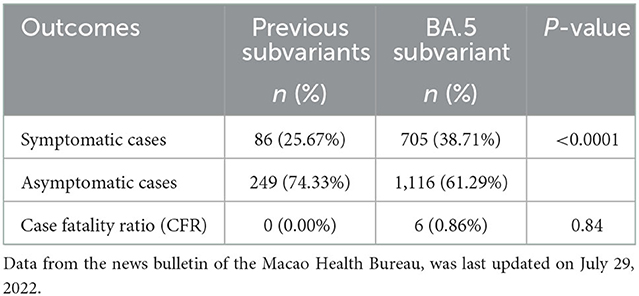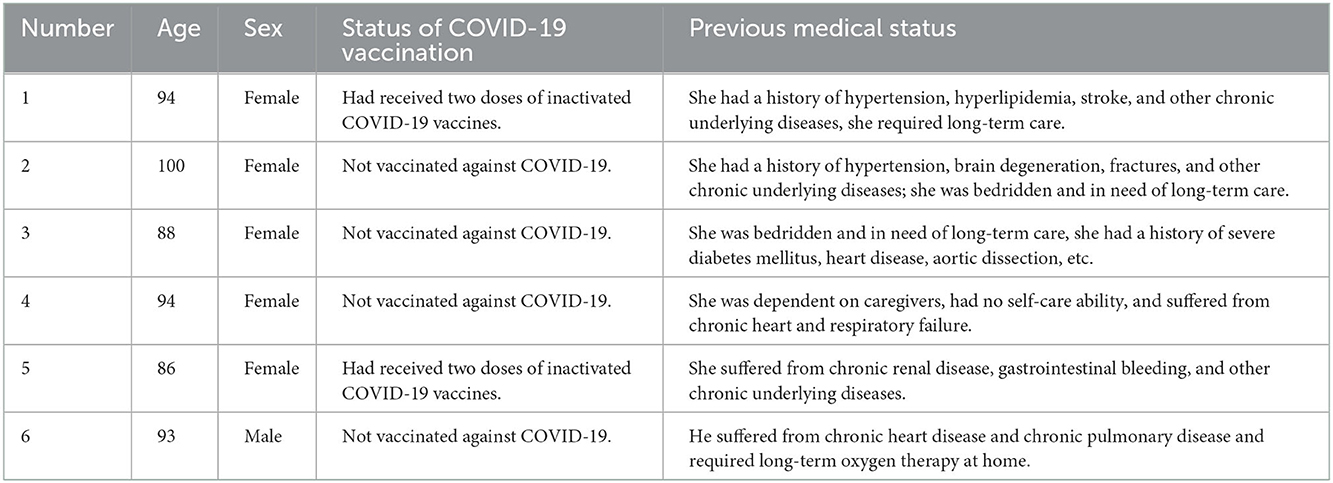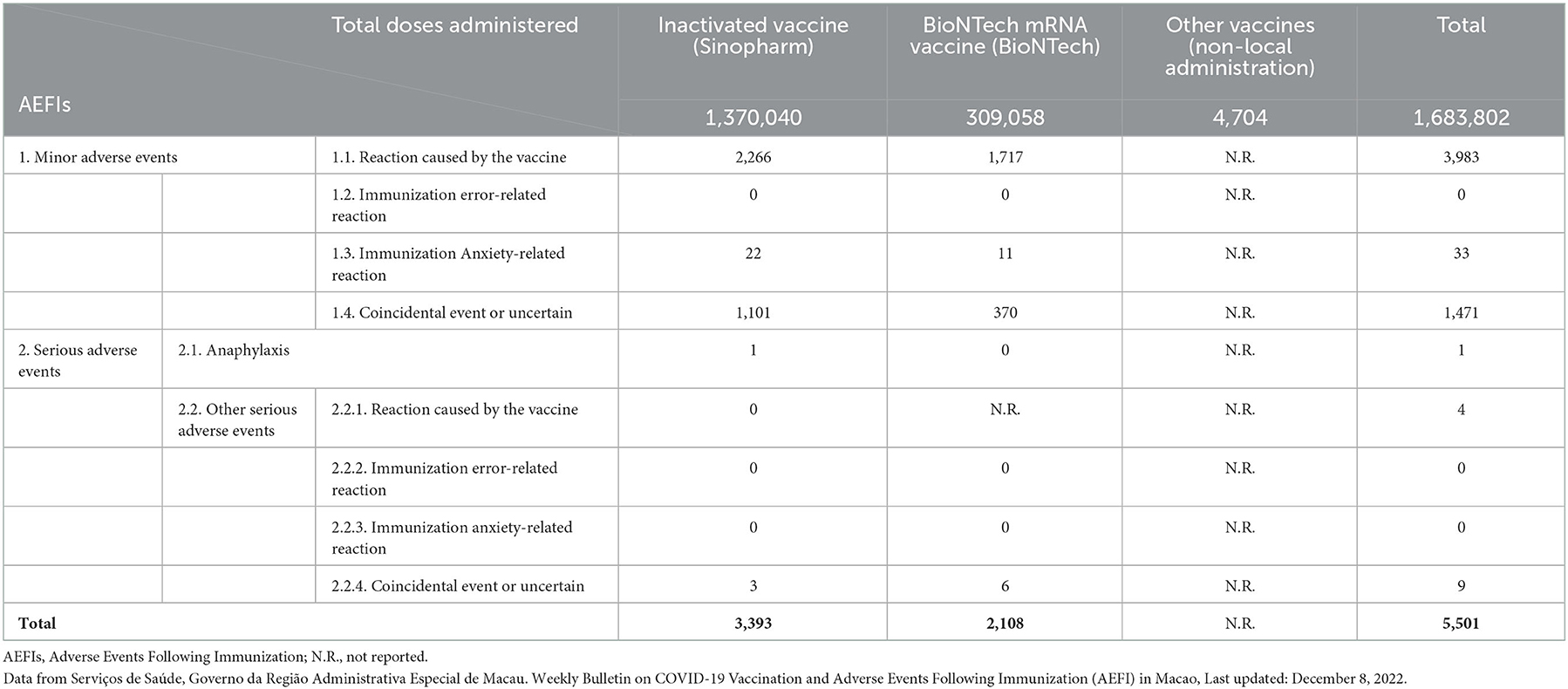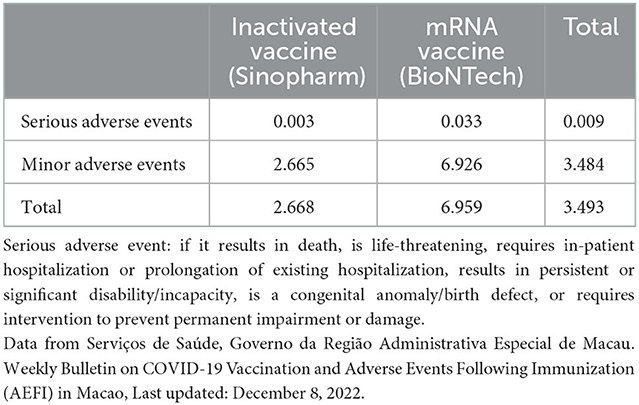- 1Faculty of Chinese Medicine, University Hospital, State Key Laboratory of Quality Research in Chinese Medicine, Macau University of Science and Technology, Taipa, Macao SAR, China
- 2College of Pharmacy, Hangzhou Normal University, Hangzhou, Zhejiang, China
- 3Department of Medical Oncology, The Affiliated Hospital of Hangzhou Normal University, Hangzhou Normal University, Hangzhou, Zhejiang, China
- 4Zhuhai Macau University of Science and Technology (MUST) Science and Technology Research Institute, Zhuhai, Guangdong, China
- 5Guangdong-Hong Kong-Macao Joint Laboratory for Contaminants Exposure and Health, Guangdong University of Technology, Guangzhou, China
Introduction: Due to its high transmissibility and immune escape, Omicron subvariant BA.5 has become the dominant strain of the SARS-CoV-2 virus and led to escalating COVID-19 cases, how to cope with it becomes an urgent issue. A BA.5 infection surge burst out on 18 June 2022 and brought an unprecedented challenge to Macau, the most densely populated region worldwide. This study aimed to analyze the characteristics of this outbreak and summarize the useful anti-epidemic measures and experiences during this outbreak.
Methods: All data were obtained from the Government Portal of Macao SAR (https://www.gov.mo), and the Special Webpage Against Epidemics, the Macao Health Bureau (www.ssm.gov.mo). An epidemiologic study was performed to analyze epidemic outcomes, including the infection rate, the proportion of symptomatic cases, the case fatality ratio (CFR), etc. Data were analyzed using SPSS Version 20. A p-value <0.05 was considered statistically significant. The anti-epidemic measures and experience were reviewed and summarized.
Results: The BA.5 outbreak resulted in 1,821 new cases, which was significantly more than the cumulative cases of the previous variants of COVID-19 in Macau. The symptomatic cases accounted for 38.71% of the total cases, which was higher than that of the previous variants. After 6-week concerted efforts, Macau effectively controlled the outbreak, with an infection rate of 0.27%, which was much lower than many BA.5-attacked regions. The CFR was approximately 0.86%, which was not statistically different from that of previous variants. Six victims were chronically ill senior elders and their vaccination rate was much lower than the average level. Macau took a comprehensive anti-epidemic strategy to win a quick victory against BA.5, especially the “relatively static” strategy that was first formulated and applied by Macau for the management of the COVID-19 pandemic. Successful experience showed that although BA.5 was highly contagious, it could be contained by comprehensive anti-epidemic measures, including adequate anti-epidemic preparation, herd immunity through vaccination, repeated mass nucleic acid tests and rapid antigen tests, KN-95 mask mandate, the “relatively static” strategy, precise prevention and control, epidemiological investigation and tracing, and traditional Chinese medicine treatment, etc.
Discussion: In Macau, compared with the previous subvariants, BA.5 is associated with increased transmissibility and a higher proportion of symptomatic cases, however, the risk of death remains similar, and the infection rate is much lower than that in many other BA.5-attacked regions. BA.5 is highly contagious but still containable, Macau's experience may offer hints for the regions experiencing the BA.5 waves to choose or adjust a more rational anti-epidemic strategy.
1. Introduction
The BA.5 variant of Omicron was first detected in February 2022 in South Africa (1, 2). Currently, it has been spreading rapidly throughout the world and leads to a significant rise in new cases and health concerns amid the ongoing wave of the COVID-19 pandemic (2, 3). Compared with previous variants (including the Alpha, Beta, Gamma, and Delta variants of SARS-CoV-2, and the BA.1, BA.2., BA.3, BA.4 lineages of Omicron, etc.) (4–7), the latest BA.5 variant is better at evading the immune system and has become the most easily transmissible variant to date (5, 8). It has gradually become the dominant strain of the SARS-CoV-2 virus in many parts of the world and has been associated with the rapidly escalating COVID-19 cases and hospitalizations.
In the U.S., BA.5 has accounted for an estimated 80% of new cases (around 100,000/day), and the number continues to grow (9, 10). The coronavirus hospitalization rate in New York has boomed by 70% in the past month (11). In Europe, the rapid spread of Omicron subvariants (BA.4 and BA.5) has also contributed to a summer surge of COVID-19. New cases have tripled and the hospitalization rates doubled over the past 6 weeks. New cases rose to 3 million in a week, accounting for nearly 50% of global new cases. There will be nearly 3,000 COVID-19 deaths every week due to the rising infection rate in older groups (12, 13). BA.5 is more than four times as vaccine-resistant as its predecessors and appears to be able to infect individuals who have been previously vaccinated and boosted against COVID-19 or have been previously infected with COVID-19 or even both. Due to the characteristics of BA.5 with strong concealment and fast transmission speed, how to cope with it becomes an urgent issue (11–15).
On 18 June, a new outbreak of COVID-19 occurred in Macao Special Administrative Region (SAR), China. As of 28 July, a total of 1,821 new COVID-19 cases have been recorded. Fortunately, adhering to the principles of scientific and precise prevention and control, Macau took a series of timely and effective anti-epidemic measures in response to epidemic changes (16). After 5-week concerted efforts, the spread of the most transmissible variant of COVID-19 has been effectively minimized, the outbreak has been successfully controlled, approaching the ultimate goal of “dynamic zero-COVID-19 strategy” in the community (17).
The COVID-19 Omicron subvariant BA.5.1 was the culprit of this largest spike in infections since the emergence of COVID-19 in Macau. To the best of our knowledge, so far, Macau is the first region in the world that took the “relatively static” control measures and active anti-epidemic strategy to win the battle against the BA.5 epidemic in a very short period (40 days), thus keeping the epidemic under control and resuming the normal socioeconomic activities as soon as possible, successful experience from Macau shows that timely and effective anti-epidemic measures, especially the “relatively static” strategy, may offer hints about the future prevention and control of the BA.5 subvariant, although BA.5 is highly contagious, insidious, and daunting, it can be contained (18).
2. Methods
All data were obtained from the Government Portal of Macao SAR (https://www.gov.mo), and the Special Webpage Against Epidemics, the Macao Health Bureau (www.ssm.gov.mo).
An epidemiologic study was performed to analyze the outcomes of the epidemic, including the infection rate of the total population, the proportion of symptomatic cases or asymptomatic cases, and the case fatality ratio among the total BA.5 subvariant cases, etc. The differences between BA.5 and the previous variants were compared. Data were analyzed using SPSS Version 20. A p-value < 0.05 was considered statistically significant. The anti-epidemic measures and experience from Macau during this outbreak of the BA.5 subvariant were reviewed and summarized.
3. Results
3.1. The facts of Omicron subvariant BA.5 in Macao SAR
In the past 2½ years, the cumulative number of COVID-19 cases in Macau was only 335 (the total population: 683.2 thousand), but a BA.5 infection surge burst out on 18 June 2022, resulting in 1,821 new cases, with six deaths, as of July 28 when the last positive case of this outbreak was reported (Figure 1) (17), which was significantly more than the cumulative cases of the previous variants of COVID-19 in Macau, suggesting that BA.5 is more transmissible than the previous subvariants. The symptomatic cases accounted for 38.71% of the total BA.5 subvariant cases, which was higher than that of the previous variants of COVID-19 (SARS-CoV-2 virus, Delta variant, Alpha variant, Omicron BA.1, etc.; 25.67%) in Macau (Table 1) (17). The COVID-19 vaccination rate in Macau was 90.04%, and most positive cases were fully vaccinated, but still infected with BA.5. The facts of Omicron subvariant BA.5 in Macau are consistent with its known characteristics: more transmissible and immune-evading, even people who are fully vaccinated are likely still at risk for BA.5.
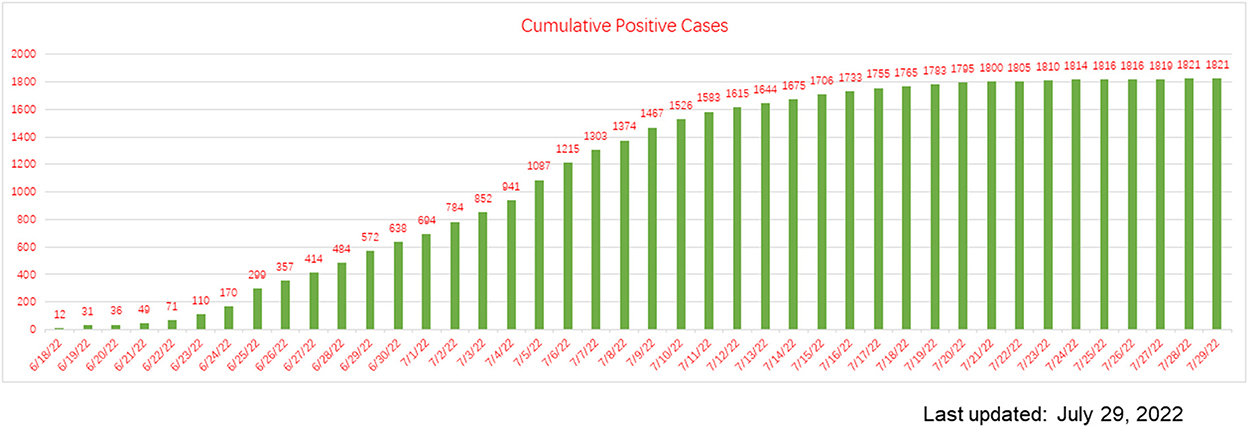
Figure 1. Cumulative positive cases during the BA.5 subvariant COVID-19 outbreak in Macau (data from the news bulletin of the Macao Health Bureau, was last updated on July 29, 2022).
The Case Fatality Ratio (CFR) of the BA.5 subvariant of COVID-19 was ~0.86%, which was not statistically different from that of previous variants, suggesting that the risk of death seemed similar between the BA.5 and previous variants (Table 1) (17). All six victims of the BA.5 subvariant were chronically ill senior elders (over 88 years old) and their vaccination rate was much lower than the average level (Table 1) (17). All the patients had a history of chronic diseases, such as heart and lung diseases, brain degeneration, fractures, hyperlipidemia, stroke, and other chronic underlying diseases (Table 2). The facts reminded us again that chronically ill elders are the most vulnerable population during the pandemic and they need focused protection and should get vaccinated or boosted as soon as possible.
3.2. Successful experience from Macao SAR
In response to this epidemic, the Macao SAR government assessed the epidemic development scientifically and adopted a series of comprehensive measures to combat the pandemic, meanwhile keeping the balance between minimizing the virus transmission and ensuring the socio-economic operation and the essential living needs of residents (17). BA.5 brought an unprecedented challenge to Macau, the most densely populated region worldwide. Fortunately, after 6-week concerted efforts, Macau effectively controlled the outbreak, with an infection rate of 0.27% (1,821/6,832,000), which was much lower than that in some BA.5-attacked regions, such as the US and Europe (9–13). Macau took a comprehensive anti-epidemic strategy to win a quick victory against BA.5, especially the “relatively static” strategy that was first formulated and applied by Macau for the management of the COVID-19 pandemic. Macau won the battle against the BA.5 epidemic in a very short period (40 days). Successful experience shows that although BA.5 is highly contagious, it can be conquered by comprehensive anti-epidemic measures, including adequate anti-epidemic preparation, herd immunity through vaccination, repeated mass nucleic acid tests and rapid antigen tests, KN-95 mask mandate, the “relatively static” strategy, precise prevention and control, epidemiological investigation and tracing, etc. The comprehensive measures are as follows, and are roughly summarized in Table 3 and Figure 2 (17).
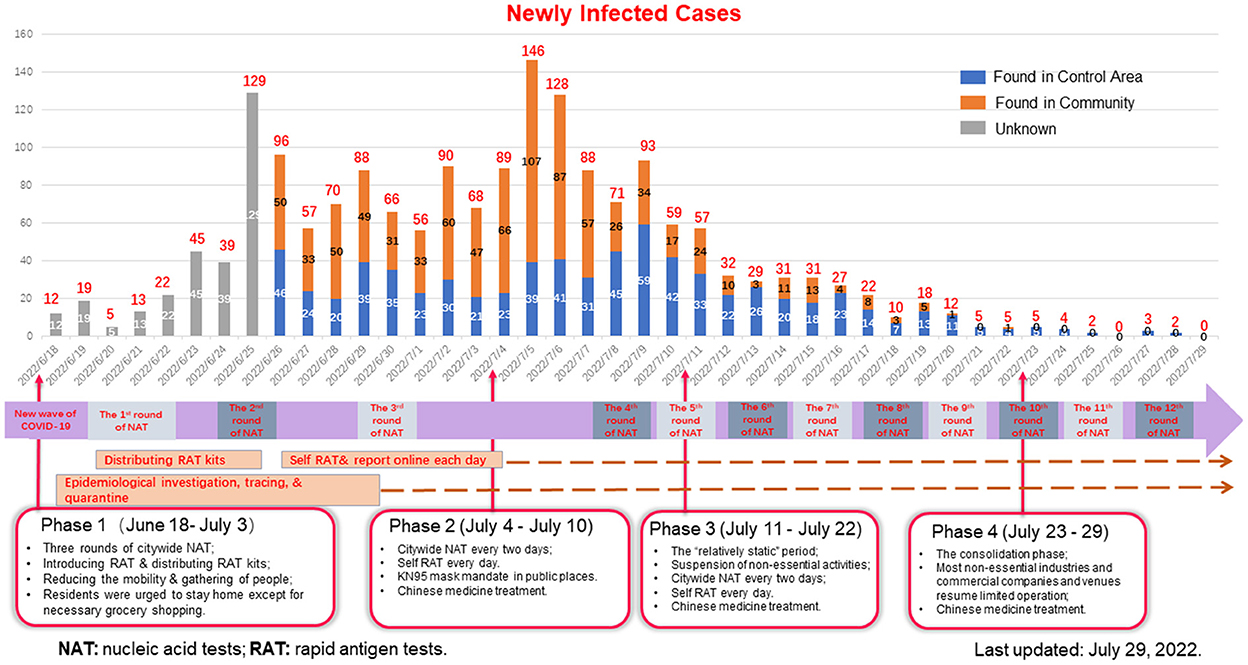
Figure 2. Daily positive cases and dynamically adjusted measures during the BA.5 subvariant COVID-19 outbreak in Macau (data from the news bulletin of the Macao Health Bureau, last updated on July 29, 2022).
3.2.1. Adequate anti-epidemic preparation in advance
In case of a large-scale outbreak, the SAR government keeps promoting the precise prevention and control level through science, continuously perfecting anti-epidemic measures, and making adequate preparation in advance. In April 2022, the SAR government prepared and formulated a 118-page “The Contingency Plan Regarding Large-scale COVID-19 Outbreak” to enact a full and rapid deployment and response in case of a large-scale COVID-19 outbreak in Macau (16). The Contingency Plan was released to the public in different languages, and drills were organized, therefore, when the BA.5 epidemic burst out, the well-prepared government, health professionals, social organizations, volunteers, and residents could respond calmly, quickly, and methodically.
Besides, the SAR government prepared and provided free adequate anti-epidemic supplies and services, such as the efficient citywide nucleic acid testing (NAT) capability, sufficient isolation and treatment facilities, information and communication outlets, epidemiological tracing capacity, the KN-95 masks, rapid antigen test (RAT) kits, etc., which laid a solid foundation for the victory in fighting the epidemic.
3.2.2. High COVID-19 vaccination rate
The WHO goal was to achieve 70% COVID-19 immunization coverage by June 2022, which remains a daunting challenge due to limited vaccine supply to some regions (19). In Macau, the COVID-19 vaccination rate has reached 90.04%, and over 86% of residents have received a second COVID-19 booster shot (20), indicating that Macau residents have achieved herd immunity against COVID-19 before this BA.5 outbreak, which might be one of the important reasons why most infected cases during the outbreak were asymptomatic (61.39%), there were very few hospitalizations or severe cases, and only six victims. The six victims were chronically ill senior elders (over 88 years old) and 4 of them did not get vaccinated (Tables 1, 2). These facts were consistent with the previous findings, although BA.5 is more adept at slipping past immune defenses, vaccination is still the best way to reduce the risks of infection, hospitalization, severe illness, and mortality (21).
Common side effects of the COVID-19 vaccines and statistics of Adverse Events Following Immunization (AEFIs) in Macau were presented in Tables 4, 5. The vaccines have succeeded in preventing severe disease or death, but more novel next-gen COVID-19 vaccines are still necessary for keeping people from catching and spreading the virus because SARS-CoV-2 has become more contagious and it is evolving to dodge the vaccines (7, 22, 23).
3.2.3. The efficient citywide nucleic acid test (NAT) capability
The SAR government kept improving the NAT capacity, the efficient mass NAT capability ensured that each round of citywide NATs for about 680,000 residents could be implemented every 2 days (usually in 36 h) (16, 17). Anyone who refused to take the NAT test would be sent to medical observation for 14 days. Vast numbers of volunteers and civil servants in Macau have participated in the epidemic prevention work with selfless dedication, residents and different sectors of the society have actively cooperated, and frontline anti-epidemic staff have been committed to their duties and responsibilities without complaint. The support of 650 samplers from mainland China significantly enhanced Macau's NAT capability (17).
3.2.4. KN-95 masks
The SAR government distributed KN-95 masks to all residents and it was a mandatory demand that members of the public should wear a KN95 mask at all times when going out or at workplaces (24). KN95 Masks can filter 95% or more airborne particles, a higher filtration rate for fine particles as compared with surgical masks, thus providing sufficient protection against the SARS-CoV-2 Omicron variant (25).
3.2.5. Daily rapid antigen test (RAT)
All people in Macau were required to take RATs every day and report the result via the “Macau Health Code app” (26). Self-RAT at home could reduce the mobility of people, the risk of transmission in the community, and the burden on medical and public health services. If the test result was declared as positive, the health code would be converted to a “red code,” one should call an ambulance to undergo a NAT as soon as possible. In addition, if one had a positive RAT, his/her roommates were not allowed to go out, and a nucleic acid test would be arranged for all of them by the authorities (26).
3.2.6. Precise prevention and control by zones and levels
Macau abided by a “zone-specific, multi-level targeted approach to epidemic prevention and control,” classified buildings with positive cases as medium or high-risk areas, and promptly implemented precise prevention and control measures according to the levels of risk. Areas were classified as “red-coded zones” and “yellow-coded zones,” with a tentative quarantine period of 7 days. Comprehensive restriction and closure management were implemented. The government catered to the daily living needs of people in the red- or yellow-coded zones (27).
3.2.7. The “relatively static” control measures
In the mainland of China, a strict lockdown plays a crucial role in the successful control of serious outbreaks of the pandemic, however, which demands huge manpower to ensure that every household in the lockdown areas gets the supply of the necessaries of life, and the precise street- or community-based committees are essential at the operation level. Similar to most countries or regions, Macau lacks the logistics support capacity, and it was almost impossible to implement a strict lockdown in Macau. Therefore, when the proportion of community infections remained high, the SAR government took the “relatively static” control management in the third stage, intending to prevent the wide spread of BA.5 in communities (17, 18).
The “relatively static” strategy (or a relative lockdown) was a unique anti-epidemic measure that Macau adopted according to its situation (a strict lockdown was impossible), which played a key role in the control of the BA.5 outbreak in Macau, measures were adopted to reduce unnecessary movement and gathering of people, to break the chains of virus transmission as soon as possible, and create necessary conditions for achieving “dynamic zero-COVID-19.” With the region-specific approach, the lockdown area was defined as small as possible, usually limited to buildings, and the residents outside of the lockdown area were ordered to stay home when community infections rapidly increased, while short trips for essential services, necessaries of life were allowed, for example, going to supermarkets or drugstores for daily necessities or medicines when necessary, thus keeping the balance between adopting rigorous pandemic measures and satisfying the basic demands of residents (17, 18).
The implementation of the “relatively static” measure inevitably brought some inconvenience to normal work and life. But, almost all residents could fulfill their civic responsibility, and strictly comply with the relevant laws and regulations on epidemic prevention, contributing to fighting against the epidemic. Since the implementation of “relatively static” management measures on 9 July, the number of new daily positive cases was gradually decreasing, with 10 cases on July 18, 2022. These results suggested that the “relatively static” measures were effective, contributing to achieving the “dynamic zero” goal (17, 18).
3.2.8. The efficient epidemiological investigation and tracing capacity
Macau continues to reinforce and upgrade the epidemiological investigation and tracing capacity, including establishing and perfecting the epidemiological contact tracing database, recruiting and training epidemiological investigation staff, rolling out the “Macao Health Code” Mobile App to receive NAT or RAT reports and record itinerary and risk assessment, posting venue QR codes for residents to scan upon entering to record their itineraries, enhancing the collaboration with the neighboring areas, thus tracing the contacts of any positive cases and its source of infection, determining the chain of infection and risk sites, making recommendations on public health measures, and arranging further examination for various risk groups (17, 18).
3.2.9. Traditional Chinese medicine (TCM) treatment
Evidence-based medicine has confirmed that TCM combined with western medicine may have clinical advantages for COVID-19 patients, such as alleviating symptoms, improving prognosis, etc. (28, 29). WHO Expert Meeting on Evaluation of TCM in the Treatment of COVID-19 recommended Member States consider the potential use of TCM for the management of COVID-19 (29). During this outbreak, the TCM practitioners actively volunteered to participate in the Chinese Medicine Anti-epidemic Team and provided consultations and guidance to the residents. Two hundred and seventy-five TCM practitioners participated in the treatment process and gave medication guidance. Finally, 74.14% (1,500/1,821) positive cases including some foreign nationals chose to receive TCM treatment and took Chinese patent medicines (30), Chinese patent medicines including Lianhua Qingwen capsules (29) and Huoxiang Zhengqi soft capsules / oral solution (31, 32) were most commonly prescribed for the patients based on their consent, which greatly facilitated to improve symptoms and promote recovery (28–32). Two hundred and sixty-eight out of the 408 (67%) foreign patients also chose to receive TCM treatment.
4. Discussion and conclusion
The mutations of novel variants facilitate the virus to dodge the immune of individuals with either vaccination or previous infection, the emergence of new variants, such as BA.5, has posed an increased risk to global public health (15, 33). Macau is the most densely populated region in the world, and the highly contagious Omicron subvariant BA.5 posed an unprecedented challenge to the prevention and treatment of COVID-19 in Macau. Macau could not choose to “lie flat” policy, on the other hand, it was extremely difficult for Macau to enforce a strict lockdown.
Since the pandemic broke out, divides have emerged about the right path out of COVID-19 (34). Currently, most countries have chosen to co-exist with coronavirus, or so-called “lying flat,” which means that epidemic control measures are relaxed, mask mandates, mass COVID-19 testing, social distancing, or quarantine is not required. But, along with the worldwide spread of BA.4 or BA.5, many countries or cities are seeing rapid spikes in COVID-19 cases, globally, there are over 6,700,000 new cases and 12,000 deaths in a week (35). Easing coronavirus policies is one of the reasons for the surge of COVID-19 new cases and hospitalizations in the relevant regions. WHO Director-General Tedros Adhanom Ghebreyesus recently expressed his concern that many countries are drastically reducing epidemic control measures (36).
According to their own situation, a few countries/regions think “lying flat” policy may bring disaster to vulnerable populations and overwhelm the healthcare system, therefore they choose to hold on to the “dynamic zero-COVID-19 strategy” goal, which is usually achieved by the strict lockdown measures, but, it is very difficult to enforce a strict lockdown and may cause counterproductive damage to the economy and living of the public (17).
Successful experience from Macao SAR indicates that Omicron subvariant BA.5 is highly contagious but still conquerable, which can be prevented and controlled by comprehensive measures including adequate preparation, vaccination, mass NAT and RAT, KN-95 masks, precise prevention and control, epidemiological investigation and tracing, TCM treatment, etc. Among them, the “relatively static” strategy is crucial for the success of epidemic control in Macau and may provide a new choice for the global fight against subvariant BA.5, the “relatively static” strategy is a middle way between “lying flat” and lockdown, aiming to strike a balance between pandemic control and enabling residents to live normal lives. The “relatively static” strategy is a unique anti-epidemic measure that Macau took according to its situation and based on the experience of other regions, and it has been proven as effective as a strict lockdown to achieve “dynamic zero-COVID-19 strategy-19” in the community even in a COVID-19 spike caused by the most contagious Omicron BA.5 (17, 18). Macau's experience may offer hints for the regions experiencing the BA.5 waves. The regions experiencing the latest variant waves may be encouraged and inspired by Macau's success and experience, thus choosing or adjusting a more suitable strategy.
Considering that the emergence of the latest Omicron variants has caused a serious situation, and the rapidly spreading viruses have chances to mutate into possibly more devastating variants, it might be necessary for regions that already removed their anti-pandemic measures to reflect and re-evaluate their COVID-19 policies. On the other hand, increasing evidence has suggested that the Omicron variants appear to be more contagious but less deadly than other lineages of the virus, with the potential decrease in toxicity of new Omicron variants and the increasing COVID-19 vaccination rate, in the long run, for those regions that hold on to a strict lockdown policy, there is also a need or a tendency to gradually relax the strict measures, thus promoting the recovery of the normal socioeconomic activities and international exchanges, but it must be a long process of exploration, Macau's experience also provides some perspective for these regions in decision-making on the strategy against the pandemic.
Data availability statement
The original contributions presented in the study are included in the article/supplementary material, further inquiries can be directed to the corresponding authors.
Author contributions
CX: conceptualization, investigation, methodology, analysis, and writing an original draft. LY and JW: investigation, validation, formal analysis, and writing and editing. XS: validation, investigation, and formal analysis. LY, XS, and QW: conceptualization, supervision, methodology, and review and revision of the draft. All authors contributed to the article and approved the submitted version.
Funding
This study was funded by the Science and Technology Development Fund, Macau SAR (File No.: 0098/2021/A2) and Science and Technology Planning Project of Guangdong Province (2020B1212030008).
Acknowledgments
We thank the Government Portal of Macao SAR and the Macao Health Bureau for sharing the relevant data and formulating professional and effective response strategies, we appreciate the concerted efforts from all health professionals, volunteers, the social public, and anyone who contributed to the victory against the epidemic.
Conflict of interest
The authors declare that the research was conducted in the absence of any commercial or financial relationships that could be construed as a potential conflict of interest.
Publisher's note
All claims expressed in this article are solely those of the authors and do not necessarily represent those of their affiliated organizations, or those of the publisher, the editors and the reviewers. Any product that may be evaluated in this article, or claim that may be made by its manufacturer, is not guaranteed or endorsed by the publisher.
References
1. Tegally H, Moir M, Everatt J, Giovanetti M, Scheepers C, Wikinson E, et al. Emergence of SARS-CoV-2 Omicron lineages BA.4 and BA.5 in South Africa. Nat Med. (2022) 28:1785–90. doi: 10.1038/s41591-022-01911-2
2. Callaway E. New Omicron relatives BA.4 and BA.5 offer hints about the future of SARS-CoV-2. Nature. (2022) 605:204–6. doi: 10.1038/d41586-022-01240-x
3. Callaway E. What Omicron's BA.4 and BA.5 variants mean for the pandemic. Nature. (2022) 606:848–9. doi: 10.1038/d41586-022-01730-y
4. Mohapatra RK, Kandi V, Verma S, Dhama K. Challenges of the Omicron (B.1.1.529) variant and its lineages: A global perspective. Chembiochem. (2022) 23:e202200059. doi: 10.1002/cbic.202200059
5. Mohapatra RK, Kandi V, Sarangi AK, Verma S, Tuli HS, Chakraborty S, et al. The recently emerged BA.4 and BA.5 lineages of Omicron and their global health concerns amid the ongoing wave of COVID-19 pandemic – Correspondence. Int J Surg. (2022) 103:106698. doi: 10.1016/j.ijsu.2022.106698
6. Mohapatra RK, Kandi V, Mishra S, Sarangi AK, Pradhan MK, Mohapatra PK, et al. Emerging novel sub-lineage BA.2.75: The next dominant omicron variant? Int J Surg. (2022) 104:106835. doi: 10.1016/j.ijsu.2022.106835
7. Chakraborty C, Bhattacharya M, Sharma AR, Mohapatra RK, Chakraborty S, Pal S, et al. Immediate need for next-generation and mutation-proof vaccine to protect against current emerging Omicron sublineages and future SARS-CoV-2 variants: An urgent call for researchers and vaccine companies – Correspondence. Int J Surg. (2022) 106:106903. doi: 10.1016/j.ijsu.2022.106903
8. Shrestha LB, Foster C, Rawlinson W, Tedla N, Bull RA. Evolution of the SARS-CoV-2 omicron variants BA.1 to BA.5: Implications for immune escape and transmission. Rev Med Virol. (2022) 20:e2381. doi: 10.1002/rmv.2381
9. Cao Y, Yisimayi A, Jian F, Song W, Xiao Y, Wang L, et al. BA.2.12.1, BA.4 and BA.5 escape antibodies elicited by Omicron infection. Nature. (2022) 608:593–602. doi: 10.1101/2022.04.30.489997
10. Phan T, Boes S, McCullough M, Gribschaw J, Marsh JW, Harrison LH, et al. Emergence of SARS-CoV-2 Omicron BA.5 variant of concern in Western Pennsylvania, United States. J Med Virol. (2022) 94:4593–4. doi: 10.1002/jmv.27945
11. NBC. COVID Hospitalization Rate in NYC Soars 70% in Month, ICU Patient Tally Nearly Doubles. (2022). Available online at: http://www.nbcnewyork.com/news/coronavirus/nys-covid-dashboard-nyc-hospitalization-rate-soars-70-in-ba5-variant-wave/3796713/ (accessed July 29, 2022).
12. SEATTLE. BA.4 and BA.5 Power a Surge of Infections in Europe, Officials Say. (2022). Available online at: http://www.seattletimes.com/nation-world/ba-4-and-ba-5-power-a-surge-of-infections-in-europe-officials-say/ (accessed July 29, 2022).
13. WHO. Rapidly Escalating COVID-19 Cases Amid Reduced Virus Surveillance Forecasts a Challenging Autumn and Winter in the WHO European Region. (2022). Available online at: http://www.who.int/europe/news/item/19-07-2022-rapidly-escalating-covid-19-cases-amid-reduced-virus-surveillance-forecasts-a-challenging-autumn-and-winter-in-the-who-european-region (accessed July 29, 2022).
14. Tanne JH. COVID-19: BA.5 variant is now dominant in US as infections rise. Br Med J. (2022) 378:o1770. doi: 10.1136/bmj.o1770
15. CNN. Why the Omicron Offshoot BA.5 Is a Big Deal. (2022). Available online at: https://edition.cnn.com/2022/07/14/health/omicron-ba-5-variant-immunity-severity/index.html (accessed July 24, 2022).
16. SSM. The Novel Coronavirus Response and Coordination Center, Macao SAR. The Contingency Plan Regarding Large-scale COVID-19 Outbreak (First Version). (2022). Available online at: http://www.ssm.gov.mo/docs2/file/p/21928/en (accessed July 24, 2022).
17. Macao SAR Government. The Novel Coronavirus Response Coordination Centre, Macao SAR. Combatting the Epidemic With Concerted Efforts, Resuming Normal Order, Life Production as Soon as Possible. (2022). Available online at: http://www.gov.mo/en/news/276443/ (accessed July 24, 2022).
18. Macaubusiness.com. Strict Lockdown Unnecessary and Counterproductive in SAR-UM Research Team. (2022). Available online at: http://www.macaubusiness.com/strict-lockdown-unnecessary-and-counterproductive-in-sar-um-research-team/ (accessed July 29, 2022).
19. World Health Organization. COVAX Statement. (2021). Available online at: https://www.who.int/news/item/23-12-2021-achieving-70-covid-19-immunization-coverage-by-mid-2022
20. SSM. Special Webpage Against Epidemics. (2022). Available online at: http://www.ssm.gov.mo/apps1/PreventCOVID-19/en.aspx#clg22916 (accessed July 29, 2022).
21. ETNT Health. Here's How Worried You Should be About BA.5. (2022). Available online at: http://www.eatthis.com/new-heres-how-worried-you-should-be-ba5-covid/ (accessed July 29, 2022).
22. Mohapatra RK, Kuppili S, Kumar Suvvari T, Kandi V, Behera A, Verma S, et al. SARS-CoV-2 and its variants of concern including Omicron: A never ending pandemic. Chem Biol Drug Des. (2022) 99:769–88. doi: 10.1111/cbdd.14035
23. Holmes B. What Next-Gen Covid-19 Vaccines Might Look Like. Knowable Magazine (2022, March 11). Available online at: https://knowablemagazine.org/article/health-disease/2022/what-nextgen-covid-19-vaccines-might-look-like (accessed December 11, 2022).
24. Macao SAR Government. Novel Coronavirus Response Coordination Centre strongly calls on the public to Take Personal Protective Measures. (2022). Available online at: http://www.gov.mo/en/news273646/ (accessed July 29, 2022).
25. Macao SAR Government. KN-95 Masks Provided by the Macao SAR Government Conform to National Standards. (2022). Available online at: http://www.gov.mo/en/news/274004/ (accessed July 29, 2022).
26. Macao SAR Government. All People in Macao Are Required to Take Rapid Antigen Test Once Every Day, From Tomorrow (29 June) to 30 June. (2022). Available online at: http://www.gov.mo/en/news/272595/ (accessed July 29, 2022).
27. Macao SAR Government. Zone-Specific, Multi-Level Targeted Approach to Epidemic Prevention Control Activated; Closure Control Measures Implemented on the Living Areas of Confirmed Case. (2022). Available online at: http://www.gov.mo/en/news/270577/ (accessed July 29, 2022).
28. WHO. Expert Meeting on Evaluation of Traditional Chinese Medicine in the Treatment of COVID-19. (2022). Available online at: http://www.who.int/publications/m/item/who-expert-meeting-on-evaluation-of-traditional-chinese-medicine-in-the-treatment-of-covid-19 (accessed July 29, 2022).
29. Hu C, Liang M, Gong F, He B, Zhao D, Zhang G. Efficacy of Lianhua Qingwen compared with conventional drugs in the treatment of common pneumonia and COVID-19 pneumonia: A meta-analysis. Evid Based Complement Alternat Med. (2020) 2020:5157089. doi: 10.1155/2020/5157089
30. Macao SAR Government. People Tested Positive in Nucleic Acid Tests Receiving Proprietary Chinese Medicines as Treatment. Novel Coronavirus Response Coordination Centre. (2022). Available online at: http://www.gov.mo/en/news/274643/ (accessed July 29, 2022).
31. Xiao M, Tian J, Zhou Y, Xu X, Min X, Lv Y, et al. Efficacy of Huoxiang Zhengqi dropping pills and Lianhua Qingwen granules in treatment of COVID-19: A randomized controlled trial. Pharmacol Res. (2020) 161:105126. doi: 10.1016/j.phrs.2020.105126
32. The Novel Coronavirus Response and Coordination Centre, Macao SAR. Macao SAR Government's Response to “18 June Outbreak” Summary Report. Macao. (2022).
33. Harvey WT, Carabelli AM, Jackson B, Gupta RK, Thomson EC, Harrison EM, et al. SARS-CoV-2 variants, spike mutations and immune escape. Nat Rev Microbiol. (2021) 19:409–24. doi: 10.1038/s41579-021-00573-0
34. SCMP. Coronavirus: Time to “Lie Flat?” Divides Emerge on Chinese Internet About Country's Path Out of COVID-19. (2022). Available online at: http://www.scmp.com/news/people-culture/social-welfare/article/3173364/coronavirus-time-lie-flat-divides-emerge-chinese (accessed July 29, 2022).
35. WHO. WHO Coronavirus (COVID-19) Dashboard. (2022). Available online at: https://covid19.who.int/table (accessed July 24, 2022).
36. WHO. WHO Concerned About Drop in COVID-19 Testing. Available online at: http://www.voanews.com/a/who-concerned-about-drop-in-covid-19-testing/6477276.html (accessed July 29, 2022).
Keywords: successful experience, Macau, Omicron subvariant BA.5, “relatively static” strategy, anti-COVID-19, containable
Citation: Xu C, Wang J, Yu L, Sui X and Wu Q (2023) Omicron subvariant BA.5 is highly contagious but containable: Successful experience from Macau. Front. Public Health 10:1029171. doi: 10.3389/fpubh.2022.1029171
Received: 26 August 2022; Accepted: 16 December 2022;
Published: 10 January 2023.
Edited by:
Zhiwen Hu, Zhejiang Gongshang University, ChinaReviewed by:
Yeyu Freddie Dai, China Wireless-Valley Technologies (HK) Ltd., ChinaAshish Kumar Kumar Sarangi, Centurion University of Technology and Management, India
Copyright © 2023 Xu, Wang, Yu, Sui and Wu. This is an open-access article distributed under the terms of the Creative Commons Attribution License (CC BY). The use, distribution or reproduction in other forums is permitted, provided the original author(s) and the copyright owner(s) are credited and that the original publication in this journal is cited, in accordance with accepted academic practice. No use, distribution or reproduction is permitted which does not comply with these terms.
*Correspondence: Lili Yu,  bGx5dUBtdXN0LmVkdS5tbw==; Xinbing Sui,
bGx5dUBtdXN0LmVkdS5tbw==; Xinbing Sui,  aHp6anVAaHpudS5lZHUuY24=; Qibiao Wu,
aHp6anVAaHpudS5lZHUuY24=; Qibiao Wu,  cWJ3dUBtdXN0LmVkdS5tbw==
cWJ3dUBtdXN0LmVkdS5tbw==
†These authors have contributed equally to this work
 Cong Xu1†
Cong Xu1† Jue Wang
Jue Wang Lili Yu
Lili Yu Xinbing Sui
Xinbing Sui Qibiao Wu
Qibiao Wu